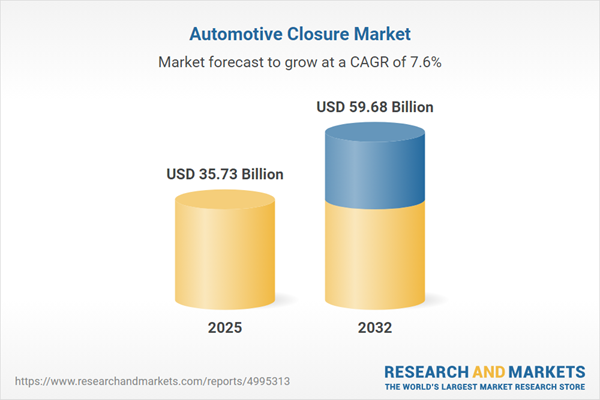Speak directly to the analyst to clarify any post sales queries you may have.
The automotive closure market is undergoing profound transformation as innovation, regulatory shifts, and evolving consumer preferences drive change. Senior executives navigating this landscape need actionable insights into trends, competitive positioning, and growth strategies that will define the coming decade.
Market Snapshot: Automotive Closure Market Growth and Outlook
The Automotive Closure Market grew from USD 33.33 billion in 2024 to USD 35.73 billion in 2025 and is projected to reach USD 59.68 billion by 2032, reflecting a robust CAGR of 7.55%. Industry expansion is propelled by increased demand for smart and lightweight closure systems, stringent safety and sustainability mandates, and rapid tech integration across global automotive manufacturing.
Scope & Segmentation: Depth and Breadth of Market Analysis
This comprehensive research dissects the market by product, component, material, technology, application, end-user, and geography. Key areas of segmentation include:
- Products: Bonnets, Back Doors, Front Doors, Fuel Doors, Rear Doors, Sunroofs, Windows
- Component Types: Actuator, Electronic Control Unit, Hinges, Latches, Relay, Switch
- Material Types: Carbon Fiber, Glass Fiber Reinforced Plastic, Aluminum, Steel, Nylon, Polycarbonate, PVC
- Type: Automatic/Electric Closures, Manual Closures
- Application: Heavy Commercial Vehicles, Light Commercial Vehicles, Hatchbacks, Sedans, SUVs
- End-User: Aftermarket, OEMs
- Regions: United States, Canada, Mexico, Brazil, Argentina, Chile, Colombia, Peru, United Kingdom, Germany, France, Russia, Italy, Spain, Netherlands, Sweden, Poland, Switzerland, United Arab Emirates, Saudi Arabia, Qatar, Turkey, Israel, South Africa, Nigeria, Egypt, Kenya, China, India, Japan, Australia, South Korea, Indonesia, Thailand, Malaysia, Singapore, Taiwan
- Companies: AISIN CORPORATION, Aptiv PLC, ATS Global B.V., Brose Fahrzeugteile GmbH & Co. KG, Cebi International S.A., Continental AG, Denso Corporation, Gentex Corporation, GRUPO ANTOLIN IRAUSA, S.A., HELLA GmbH & Co KgaA, Huf Hülsbeck & Fürst GmbH & Co. KG, Inteva Products LLC, Johnson Electric Holdings Limited, Kiekert AG, Magna International Inc., Mitsuba Corporation, Nippon Seiki Co. Ltd., Omron Corporation, Panasonic Corporation, Robert Bosch GmbH, Tata AutoComp Systems Ltd., Toyoda Gosei Co., Ltd., Toyota Boshoku Corporation, Valeo SA, Visteon Corporation, Yazaki Corporation, ZF Friedrichshafen AG
Key Takeaways: Strategic Insights for Senior Decision-Makers
- Technology integration is accelerating, with advanced actuators, electronic controls, and sensors transforming closures into integral elements of vehicle safety and user experience.
- Lightweight materials and composite innovations, such as polymer composites and reinforced plastics, are in increasing demand to meet efficiency, sustainability, and performance goals.
- Shifts in consumer preferences toward connectivity, customization, and automated features are driving diversification in closure system design and aftermarket retrofit opportunities.
- Regional market strategies are evolving rapidly; North America is emphasizing local production and innovation clusters, while Asia-Pacific leads in cost-effective manufacturing and electronic module integration.
- OEM and Tier supplier partnerships focused on digital prototyping, material advancements, and vertical integration are reinforcing competitive positioning in supply-constrained environments.
Tariff Impact: Navigating New Trade Realities
The imposition of new tariffs by the United States is creating cost challenges and production realignment across the automotive closure supply chain. Manufacturers are reshoring critical subassemblies and collaborating with domestic partners to manage cost structures, safeguard innovation, and adapt to shifting trade policies. This realignment is further spurred by regional incentives, expediting time-to-market for advanced closure technologies.
Methodology & Data Sources
The research employs structured interviews with OEM and supplier executives, triangulated with regulatory reviews, patent analyses, and proprietary datasets. Insights are validated through expert workshops and iterative peer review to ensure decision-ready accuracy.
Why This Report Matters
- Empowers leaders with deep visibility into supply chain shifts, emerging materials, and innovation priorities in the automotive closure market.
- Enables strategic planning by revealing trends in electrification, automation, consumer demand, and regional policy frameworks.
Conclusion: Charting a Path Forward in the Automotive Closure Market
Senior stakeholders equipped with granular market insight and strategic foresight are best positioned to leverage innovation, adapt to regulatory dynamics, and drive sustainable growth within the evolving automotive closure ecosystem.
Additional Product Information:
- Purchase of this report includes 1 year online access with quarterly updates.
- This report can be updated on request. Please contact our Customer Experience team using the Ask a Question widget on our website.
Table of Contents
3. Executive Summary
4. Market Overview
7. Cumulative Impact of Artificial Intelligence 2025
Companies Mentioned
The companies profiled in this Automotive Closure market report include:- AISIN CORPORATION
- Aptiv PLC
- ATS Global B.V.
- Brose Fahrzeugteile GmbH & Co. KG
- Cebi International S.A.
- Continental AG
- Denso Corporation
- Gentex Corporation
- GRUPO ANTOLIN IRAUSA, S.A.
- HELLA GmbH & Co KgaA,
- Huf Hülsbeck & Fürst GmbH & Co. KG
- Inteva Products, LLC
- Johnson Electric Holdings Limited
- Kiekert AG
- Magna International Inc.
- Mitsuba Corporation
- Nippon Seiki Co., Ltd.
- Omron Corporation
- Panasonic Corporation
- Robert Bosch GmbH
- Tata AutoComp Systems Ltd.
- Toyoda Gosei Co., Ltd.
- Toyota Boshoku Corporation
- Valeo SA
- Visteon Corporation
- Yazaki Corporation
- ZF Friedrichshafen AG
Table Information
| Report Attribute | Details |
|---|---|
| No. of Pages | 188 |
| Published | November 2025 |
| Forecast Period | 2025 - 2032 |
| Estimated Market Value ( USD | $ 35.73 Billion |
| Forecasted Market Value ( USD | $ 59.68 Billion |
| Compound Annual Growth Rate | 7.5% |
| Regions Covered | Global |
| No. of Companies Mentioned | 28 |









